Self Watering Plant Pots
Self Watering Outdoor Pots: Do They Work?
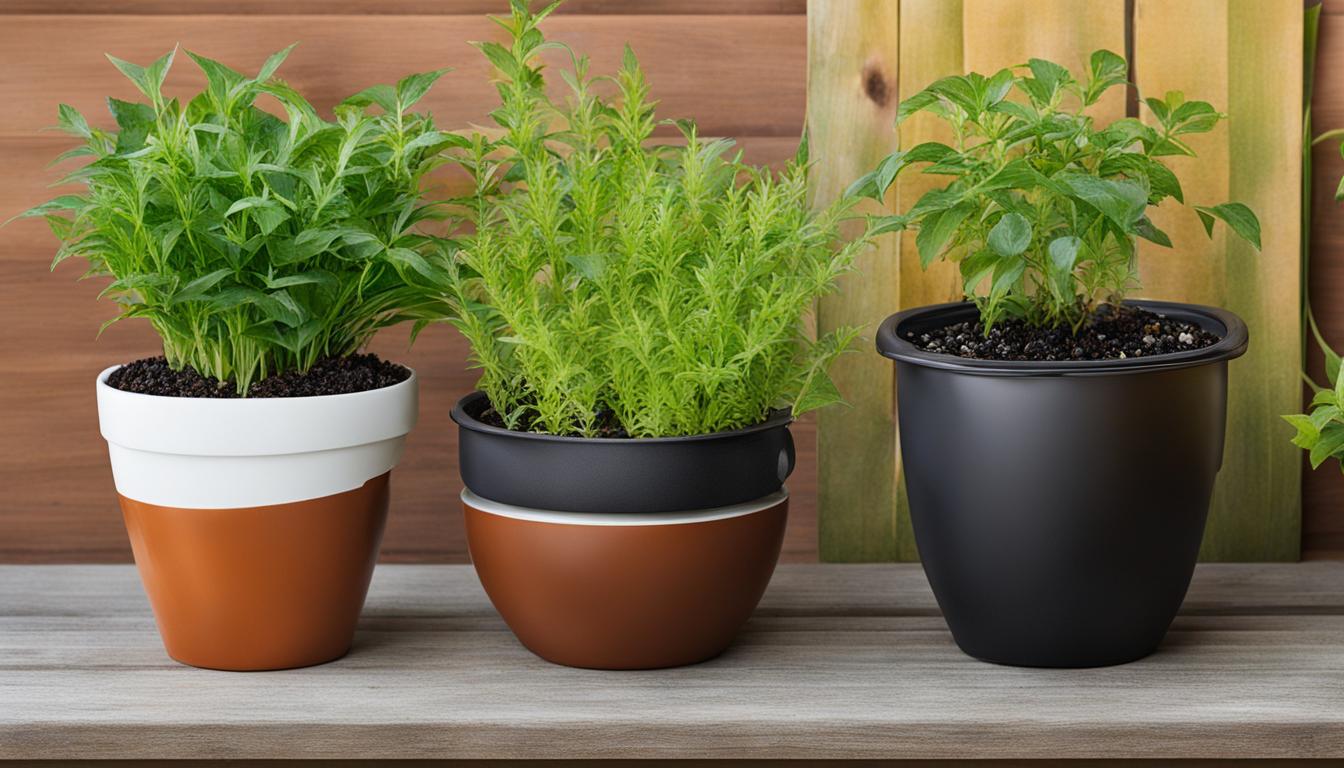
Transforming your garden into a flourishing paradise should feel as easy as a leisurely walk in the park. The key to nurturing healthy, lively plants is quite simple: make sure they’re consistently nourished and content! Introducing **self-watering outdoor pots**. These clever pots are creating a stir among garden enthusiasts for their capacity to maintain optimal hydration for your plant companions, allowing them to thrive while you take it easy. Yet, do they really stand up to their reputation? Let’s delve deeper to uncover the reality.
Self-watering pots are designed with a built-in water reservoir, which eliminates the need for daily watering. The potting soil acts as a wick, drawing water from the reservoir to the plant’s roots through capillary action. This ensures a steady and consistent water supply, preventing both under and overwatering.
These pots are suitable for a variety of plant types, offering convenience for gardeners with busy schedules. However, plants that prefer drier conditions may not do well in self-watering pots, as the moisture levels are consistently higher. It’s important to consider the specific needs of your plants before choosing this watering solution.
Self-watering pots are not only convenient but also environmentally friendly. They conserve water by delivering it directly to the roots, minimizing wastage. Additionally, they prevent excess water from pooling and causing root rot, promoting healthier plant growth.
While self-watering pots are a great solution for regular watering needs, they do have their limitations. These pots do not detect weather conditions, so they may require additional monitoring during humid or rainy periods. It’s also essential to maintain proper drainage and avoid mosquito breeding by regularly cleaning and maintaining the pots.
Key Takeaways:
- Self-watering outdoor pots provide a convenient solution for busy gardeners.
- They save time and conserve water by delivering moisture directly to the plant’s roots.
- Not all plants thrive in self-watering pots, especially those that prefer drier conditions.
- Monitoring is necessary during humid or rainy periods.
- Regular maintenance is important to ensure proper drainage and prevent mosquito breeding.
How Do Self-Watering Pots Work?
Self-watering pots are designed to provide a continuous water supply to plants, ensuring they stay healthy and hydrated. The ingenious mechanism behind these pots involves a simple yet effective process.
The self-watering pot consists of a built-in reservoir at the bottom, which serves as a water storage unit. This reservoir holds water, providing a reservoir for the plants to draw from. The soil in the pot acts as a wick, naturally pulling water from the reservoir up to the plant’s roots through capillary action.
This bottom-up watering system is crucial in maintaining a consistent supply of water to the plants. Through the process of capillary action, the porous soil gradually absorbs the water from the reservoir, creating a moisture gradient that allows the roots to draw in water as needed.
The capillary action ensures that excess water is prevented from accumulating in the pot, as any surplus water will drain back into the reservoir. This helps to prevent overwatering and root rot, allowing the plants to thrive in a well-maintained and balanced moisture environment.
To ensure the self-watering pot functions optimally, the reservoir needs to be periodically filled with water. The frequency of refilling depends on the specific water requirements of the plant and the size of the pot’s reservoir. Typically, it is recommended to refill the reservoir every one to two weeks, but closely monitoring the moisture level and the plant’s needs is key to maintaining its health.
Self-watering pots offer an efficient and convenient solution for gardeners, ensuring plants receive a consistent water supply without the need for frequent manual watering. This makes them an excellent choice for busy individuals or those who may have difficulty keeping up with regular watering schedules.
Benefits of Self-Watering Pots:
- Convenient watering solution for busy gardeners
- Conserves water and prevents overwatering
- Promotes healthy root growth
- Suitable for a wide range of plant varieties
With their innovative design and practical functionality, self-watering pots have revolutionized the way we care for our plants. Their ability to provide a reliable and consistent water supply contributes to healthier, more thriving plants.
Benefits of Self-Watering Pots
Self-watering pots provide numerous benefits for gardeners, making them a popular choice for plant enthusiasts. Let us explore the advantages of using self-watering pots:
- Convenience: Busy gardeners who may not have the time to water their plants regularly can benefit greatly from self-watering pots. These innovative pots automate the watering process, ensuring that your plants receive the necessary moisture consistently.
- Water Conservation: With self-watering pots, you can say goodbye to wasted water. These pots deliver water directly to the plant’s roots, preventing excessive watering and reducing water waste. The reservoir design allows for controlled water distribution, providing plants with just the right amount of moisture.
- Healthy Root Growth: The self-watering system promotes healthy root development by supplying water from the bottom of the pot. This encourages plants to develop robust root systems, making them more resilient and better able to absorb nutrients from the soil.
- Versatility: Self-watering pots are suitable for a wide range of plant varieties, including vegetables, herbs, and annuals. Whether you’re growing tomatoes, basil, or vibrant flowers, self-watering pots can provide the ideal environment for your plants to thrive.
- Vacation Care: Going on vacation? Self-watering pots can be an excellent solution for keeping your plants hydrated and healthy in your absence. By filling the reservoir before leaving, you can rest assured that your plants will receive adequate water throughout your time away.
Overall, self-watering pots offer convenience, water conservation, promote healthy root growth, and accommodate various plant types. They are particularly beneficial for individuals with busy schedules or those who enjoy weekend getaways.
Now, let’s take a closer look at how self-watering pots work in section 4.

The benefits of self-watering pots:
| Benefits | Description |
|---|---|
| Convenience | Automates watering process, ideal for busy gardeners. |
| Water Conservation | Reduces water waste and provides controlled water distribution. |
| Healthy Root Growth | Encourages robust root systems and nutrient absorption. |
| Versatility | Suitable for various plant types, including vegetables and herbs. |
| Vacation Care | Keeps plants hydrated during extended periods of absence. |
Advantages of Self-Watering Pots
Self-watering pots offer numerous advantages that make them a popular choice among gardeners. These pots provide a range of benefits, including:
- Nutrient Retention: Self-watering pots help to retain nutrients in the soil, promoting healthy plant growth and development.
- Water Conservation: By slowly releasing water into the soil, self-watering pots minimize water loss through evaporation, making them a water-efficient option.
- Root Growth Stimulation: The deep watering provided by self-watering pots stimulates root growth, resulting in stronger and healthier plants.
- Ability to Grow Exotic Plant Species: Self-watering pots allow the growth of exotic plants that may require regular and adequate watering, expanding the range of plants that can be cultivated.
Overall, self-watering pots provide an effective and convenient solution for maintaining plants’ watering needs while offering additional benefits that contribute to the overall health and growth of the plants.
Advantages of Self-Watering Pots
| Advantages | Description |
|---|---|
| Nutrient Retention | Helps to retain nutrients in the soil, promoting healthy plant growth. |
| Water Conservation | Reduces water loss through evaporation, making it a water-efficient option. |
| Root Growth Stimulation | Stimulates root growth, resulting in stronger and healthier plants. |
| Ability to Grow Exotic Plant Species | Allows the growth of exotic plants that require regular watering. |
Table 4: Advantages of Self-Watering Pots
These advantages make self-watering pots a valuable tool for gardeners who want to ensure optimal plant health and growth while minimizing water usage.
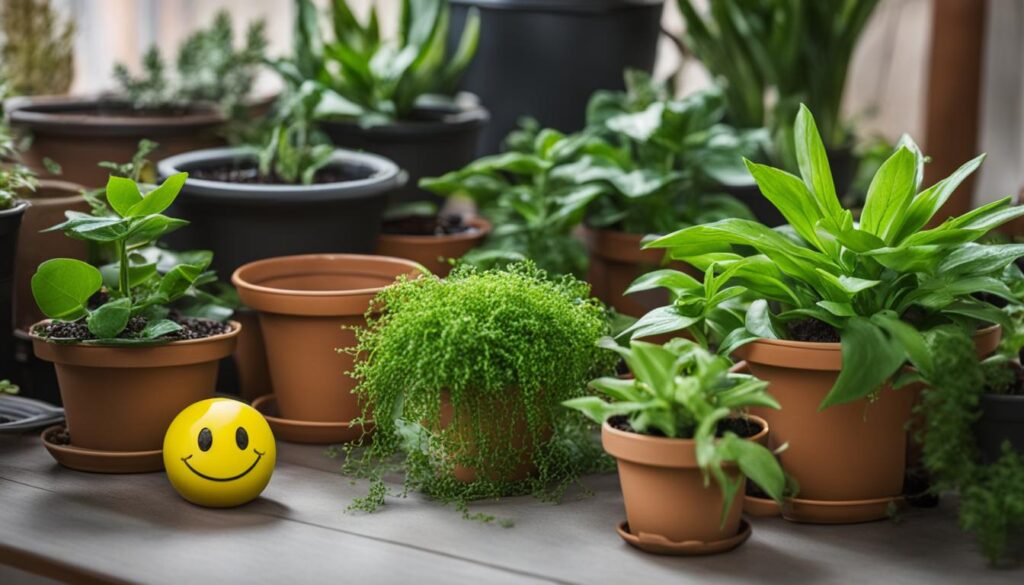
Considerations for Self-Watering Pots
While self-watering pots have many benefits, there are some important factors to consider when using them. Not all plants are suitable for self-watering pots, as some prefer drier conditions and well-drained soil. Plants like succulents and cacti, which thrive in arid environments, may not fare well in self-watering pots due to the consistent moisture they provide.
One consideration to keep in mind is water conservation. While self-watering pots are designed to be efficient, they may not always detect environmental factors like rain or humidity. This can result in the continuous release of water, leading to potential water waste. It’s important to be mindful of the water levels in the reservoir and adjust accordingly to avoid overwatering.
Another factor to consider is regular maintenance. Self-watering pots need proper drainage to prevent waterlogging and mosquito breeding. Checking the drainage system and cleaning the pot periodically is essential to ensure the longevity of the plants and the pot’s functionality.
“Not all plants are suitable for self-watering pots.”
Overall, while self-watering pots can be a convenient and effective solution for plant care, it’s essential to choose the right plants and be mindful of water conservation and maintenance to ensure optimal results.
Style and Cost of Self-Watering Pots
When it comes to self-watering pots, there is no shortage of options to suit your style and budget. These innovative pots come in various styles, sizes, and materials, allowing you to find the perfect fit for your outdoor plants. Whether you prefer sleek black pots, minimalist white designs, or the timeless charm of concrete, there is a self-watering pot to match your aesthetic preferences.
For those looking to make a statement, larger planter styles and wall features are available, adding a touch of elegance and versatility to your garden. Window boxes are another popular choice, combining functionality with an attractive display of cascading flowers or herbs.
When it comes to cost, self-watering pots may have a higher price tag compared to standard pots initially. However, they can be a wise investment in the long run. By reducing water bills and preventing plant loss, these pots can save you money over time. The cost of self-watering pots varies depending on the size and style you choose, ensuring there is a suitable option for every budget.

Comparison Table: Self-Watering Pot Styles and Prices
| Style | Description | Price Range |
|---|---|---|
| Simple Pots | Classic designs in black, white, or concrete | $10 – $30 |
| Planter Styles | Larger pots with elevated designs | $30 – $100 |
| Wall Features | Pots designed for vertical gardens | $50 – $150 |
| Window Boxes | Pots specifically designed for windowsills | $20 – $50 |
As seen in the table above, self-watering pots offer a range of styles and price points, making it possible to find the perfect fit for your outdoor space. Consider your plant type, space availability, and personal taste to choose the self-watering pots that will enhance the beauty of your garden while providing the convenience of automated watering.
DIY Self-Watering Systems
If you enjoy DIY projects and want to save some money, creating your own self-watering system is a great option. There are numerous online tutorials available that provide step-by-step instructions to help you build a DIY self-watering system using easily accessible materials. By crafting your own self-watering system, you can personalize it to suit your garden’s specific needs while also being more economical. However, it is crucial to ensure proper construction and functionality to avoid any water leakage or other potential issues.
Advantages of DIY Self-Watering Systems
Building your own self-watering system offers several advantages:
- Cost-Effectiveness: DIY self-watering systems can be more affordable compared to purchasing pre-made self-watering pots or systems.
- Customization: You can design and customize the self-watering system to fit the size and style of your plants or garden.
- Control: With a DIY system, you have direct control over the construction and can ensure its efficacy and longevity.
- Flexibility: As your garden expands or changes, you can easily modify or expand your DIY self-watering system accordingly.
Creating a DIY self-watering system allows you to exercise your creativity while also being environmentally conscious. By repurposing common household items or utilizing inexpensive materials, you can achieve the same benefits as store-bought solutions. Just make sure to follow reliable tutorials and consider the specific needs of your plants.
“Building your own self-watering system can be a fun and rewarding DIY project. By utilizing easily available materials and following step-by-step instructions, you can create a personalized and cost-effective solution for your garden.” – Expert Gardener
Step-by-Step Guide: Building a DIY Self-Watering System
- Gather the necessary materials: A reservoir container, a growing container (pot or planter), a wicking material (such as a cotton rope or capillary mat), potting soil, and plants.
- Prepare the reservoir container: Drill a small hole near the bottom of the container for water drainage. This hole will prevent overwatering and waterlogging.
- Assemble the wicking system: Place the wicking material in the reservoir container, ensuring it extends from the bottom of the container and sticks out slightly above the container’s rim.
- Add potting soil: Fill the growing container with potting soil, leaving enough space at the top for planting your desired plants.
- Plant your plants: Make small holes in the soil and gently place your plants, ensuring they are well-anchored and surrounded by soil.
- Connect the reservoir container: Position the reservoir container next to or underneath the growing container, making sure the wicking material extends into the soil. The reservoir container will supply water to the plants through the wicking material.
- Test and adjust: Pour water into the reservoir and observe how the wicking system distributes the water to the plants. Adjust the wicking material and the amount of water as necessary to achieve the desired watering effect.
Remember to monitor your DIY self-watering system regularly, ensuring that the reservoir is refilled when necessary and the plants are healthy. With a properly constructed DIY self-watering system, you can enjoy a thriving garden with less effort and water wastage.
| Advantages of DIY Self-Watering Systems | Step-by-Step Guide |
|---|---|
|
|
By following a step-by-step guide and utilizing readily available materials, you can create a functional and efficient DIY self-watering system for your garden. Enjoy the satisfaction of creating a personalized solution while keeping your plants hydrated and healthy.
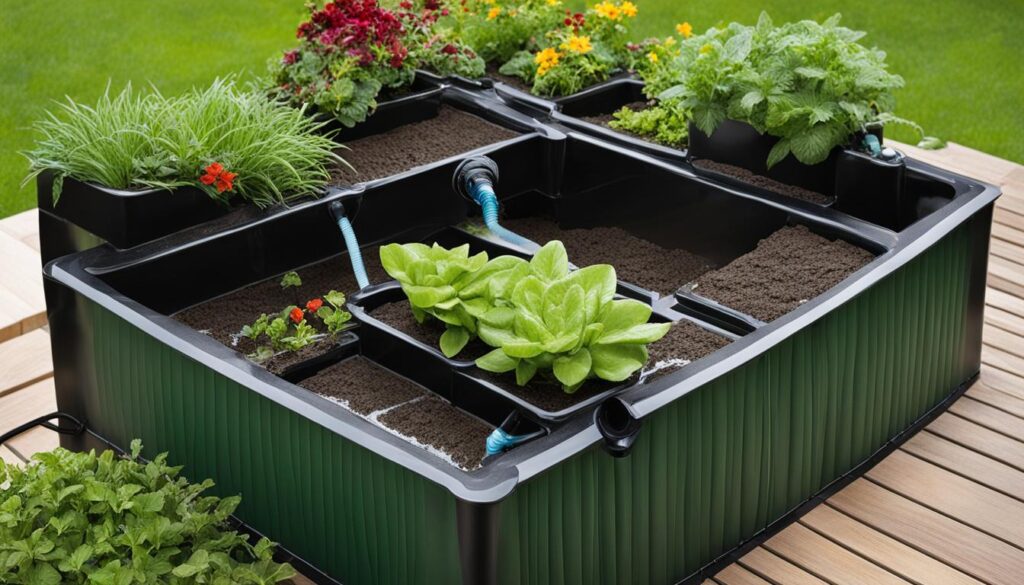
Self-Watering Pots for Vacation Care
When you’re planning a vacation, taking care of your plants can be a concern. With self-watering pots, you can enjoy your time away without worrying about your plants getting thirsty. These innovative pots provide a reliable watering system that keeps your plants hydrated even when you’re not around.
Before you leave, make sure to fill the reservoir of your self-watering pot with water. This reservoir acts as a water source for your plants, supplying them with the moisture they need to thrive. Depending on the size of the reservoir and the water requirements of your plants, you may only need to fill it once or twice throughout your vacation.
If you have a trusted friend, neighbor, or family member nearby, you can ask them to check on your self-watering pot periodically. They can ensure that the reservoir is still filled with water and that everything is functioning properly. This extra set of eyes can provide peace of mind and ensure that your plants continue to receive the care they need.
“I’ve used self-watering pots for vacation care multiple times, and I’ve always come back to healthy, happy plants,” says Rebecca, a frequent vacationer and plant enthusiast. “It’s such a relief to know that my plants are being taken care of while I’m away. I highly recommend self-watering pots for anyone who loves to travel.”
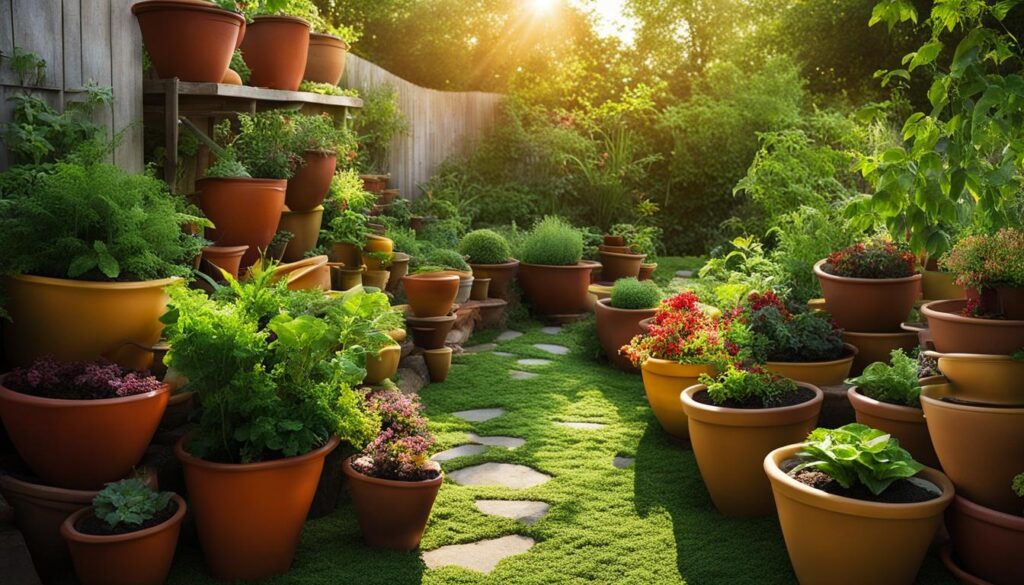
Benefits of Self-Watering Pots for Vacation Care
- Reliable watering system: Self-watering pots ensure that your plants receive a consistent supply of water, even in your absence.
- Peace of mind: You can enjoy your vacation knowing that your plants are being taken care of.
- Plant health and vitality: Self-watering pots provide the right amount of moisture to keep your plants healthy and thriving.
- Convenience: No need to rely on others to water your plants or worry about overwatering.
- Water conservation: Self-watering pots are designed to prevent water waste, making them an eco-friendly option.
With self-watering pots, you can have beautiful, thriving plants waiting for you when you return from your vacation. So go ahead, plan that well-deserved getaway, and let your self-watering pots take care of your plants in the meantime.
Are Self-Watering Pots Suitable for All Plants?
While self-watering pots offer numerous advantages, it is important to note that not all plants thrive in these systems. Certain plant species, such as succulents, cacti, and Mediterranean herbs, prefer drier conditions and well-drained soil. The consistent moisture provided by self-watering pots may not align with their specific watering needs, potentially leading to root rot and other issues.
Before deciding to use a self-watering pot, it is crucial to consider the water requirements and preferences of each plant. Some plants may benefit from the convenience and efficiency of a self-watering system, while others may require manual watering or alternative methods.
“Not all plants are suitable for self-watering pots.”
Plants Suitable for Self-Watering Pots
There is a wide range of plant varieties that can thrive in self-watering pots. These include:
- Leafy greens, such as lettuce and spinach
- Herbs, like basil, parsley, and mint
- Small to medium-sized vegetables, including tomatoes, peppers, and cucumbers
- Flowering plants, such as marigolds, petunias, and geraniums
These plants typically benefit from consistent moisture and can adapt well to the self-watering system. However, it is essential to monitor their water intake and adjust the watering frequency accordingly.
| Plant Name | Watering Needs | Suitability for Self-Watering Pots |
|---|---|---|
| Lettuce | Regular, consistent moisture | High suitability |
| Basil | Regular watering, but avoid over-saturation | High suitability |
| Tomatoes | Moderate watering, with more during fruiting | Medium suitability |
| Marigolds | Regular watering, but avoid excessive moisture | High suitability |
As illustrated in the table above, certain plants are better suited for self-watering pots than others. It is important to consider the specific watering needs and moisture requirements of each plant to ensure their successful growth in a self-watering system.
By selecting plants that are compatible with self-watering pots, gardeners can enjoy the convenience and efficiency of these systems while promoting healthy plant growth. Remember to provide appropriate plant care, monitor water levels, and adjust watering schedules as needed to optimize the benefits of self-watering pots.
Conclusion
Self-watering outdoor pots are an excellent choice for gardeners looking for a convenient and efficient way to maintain healthy plants. With their ability to provide a consistent water supply directly to the roots, these pots save time and reduce water waste. However, it’s crucial to carefully select the right plants for self-watering pots and consider environmental conditions and maintenance requirements.
When it comes to self-watering pots, there is a wide range of styles and price ranges available, ensuring that every gardener can find the perfect fit for their needs. Whether you opt for pre-made self-watering pots or decide to embark on a DIY project, the benefits are undeniable. These pots can be a valuable tool in keeping your outdoor plants thriving throughout the year.
When choosing the best self-watering pots, consider the size and style that suit your garden aesthetic and the specific requirements of your plants. Look for pots made from durable materials that will withstand the outdoor elements and ensure long-lasting use. By investing in high-quality self-watering pots, you can enjoy the convenience and efficiency they offer for years to come.
FAQ
Do self-watering outdoor pots work?
Yes, self-watering outdoor pots work by using a reservoir at the bottom to hold water. The soil in the pot acts as a wick, pulling water from the reservoir up to the plant’s roots through capillary action.
How do self-watering pots work?
Self-watering pots work by utilizing a bottom-up watering system. The reservoir at the bottom holds water, and the soil in the pot acts as a wick, pulling water up to the plant’s roots. This ensures a consistent supply of water and prevents excess water accumulation.
What are the benefits of self-watering pots?
Self-watering pots offer several benefits, including convenience for busy gardeners, water conservation, healthy root growth, and the ability to support various plant varieties. They provide a convenient watering solution, conserve water by delivering the right amount of moisture directly to the roots, and promote healthy plant growth.
What are the advantages of self-watering pots?
There are several advantages to using self-watering pots. They help retain nutrients in the soil, conserve water by minimizing evaporation, stimulate root growth for stronger plants, and enable the growth of plants with specific watering needs, such as exotic plant species.
What should I consider when using self-watering pots?
When using self-watering pots, it is important to consider the water requirements and preferences of the plants. Not all plants are suitable for self-watering pots, as some prefer drier conditions and well-drained soil. Additionally, self-watering pots may not detect external factors like rain or humidity, so monitoring and maintenance are necessary.
What is the style and cost range of self-watering pots?
Self-watering pots come in various styles, sizes, and materials. They range from simple pots in black, white, or concrete to larger planter styles and even wall features or window boxes. The cost of self-watering pots varies depending on the size and style chosen.
How can I create my own self-watering system?
If you enjoy DIY projects, you can create your own self-watering system using readily available materials. There are many tutorials available online that provide step-by-step instructions on building a self-watering system. DIY self-watering systems can be a more economical and personalized option for enhancing your garden.
Are self-watering pots suitable for vacation care?
Yes, self-watering pots are a popular choice for vacation care. They provide a reliable watering system that can keep plants hydrated while you are away. Before leaving, the reservoir should be filled with water, and if needed, a friend or neighbor can check on the self-watering pot periodically.
Are self-watering pots suitable for all plants?
Not all plants are suitable for self-watering pots. Plants that prefer drier conditions, such as succulents, cacti, and Mediterranean herbs, may not thrive in self-watering systems. It is important to consider the water requirements and preferences of each plant before deciding to use a self-watering pot.
What are the best self-watering pots?
The best self-watering pots may vary depending on individual needs and preferences. It is recommended to choose self-watering pots that meet the specific requirements of the plants being grown and fit the desired aesthetic. Various reputable brands offer high-quality self-watering pots, so researching and reading reviews can help in making the best choice.
With a green thumb and a keen eye for detail, Kayla leads our content with expertise and enthusiasm. Her dedication to spreading the joy of home gardening is reflected in every piece of advice and tip shared. She ensures that our community receives the most reliable and practical gardening insights.
Self Watering Plant Pots
Self Watering Plant Pots Indoor
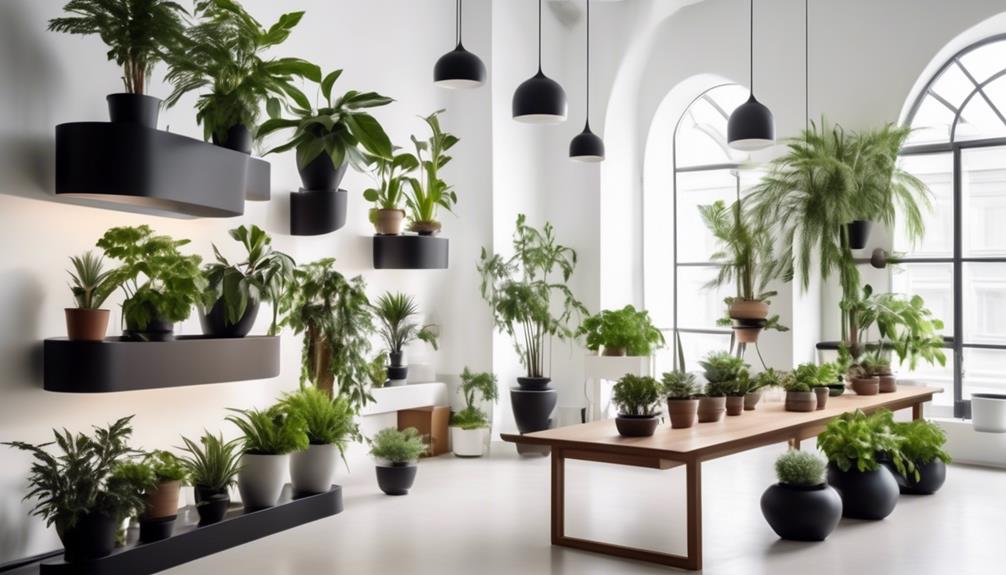
We’ve all been there – witnessing a previously lush plant by the window now looking more like a dried-up tumbleweed. Say hello to the self-watering plant pot, a groundbreaking invention aimed at maintaining the vitality and flourishing state of our indoor plants with minimal effort.
But do these self-watering pots actually live up to the hype? Let's explore the science behind their design, the benefits they offer, and how to choose the right one for your indoor garden.
Whether you're a seasoned plant parent or just dipping your toes into the world of indoor gardening, there's something intriguing about the idea of a pot that waters itself.
Key Takeaways
- Self-watering plant pots provide convenient and efficient moisture for indoor plants.
- They reduce the need for frequent watering and minimize the risk of over or under-watering.
- Self-watering pots promote water conservation and prevent water wastage.
- They contribute to healthy plant growth and long-term cost savings.
Benefits of Self-Watering Plant Pots
Self-watering plant pots offer a convenient and efficient method for providing consistent moisture to indoor plants, reducing the need for frequent watering and minimizing the risk of over or under-watering. These pots serve as cost-effective alternatives by conserving water and reducing water usage. The self-watering mechanism prevents water wastage by delivering water directly to the plant's roots, ensuring optimal moisture levels and promoting healthy plant growth. This not only saves time and effort but also contributes to cost savings in the long run.
Moreover, the environmental impact of self-watering plant pots is noteworthy. By promoting water conservation, these pots play a crucial role in sustainable indoor gardening. They help in minimizing water runoff and leaching of fertilizers, thus reducing the overall environmental footprint. Additionally, the controlled watering system prevents waterlogging, which can lead to soil degradation and nutrient leaching. This contributes to maintaining a healthy indoor environment while also supporting ecological sustainability.
How Self-Watering Pots Work
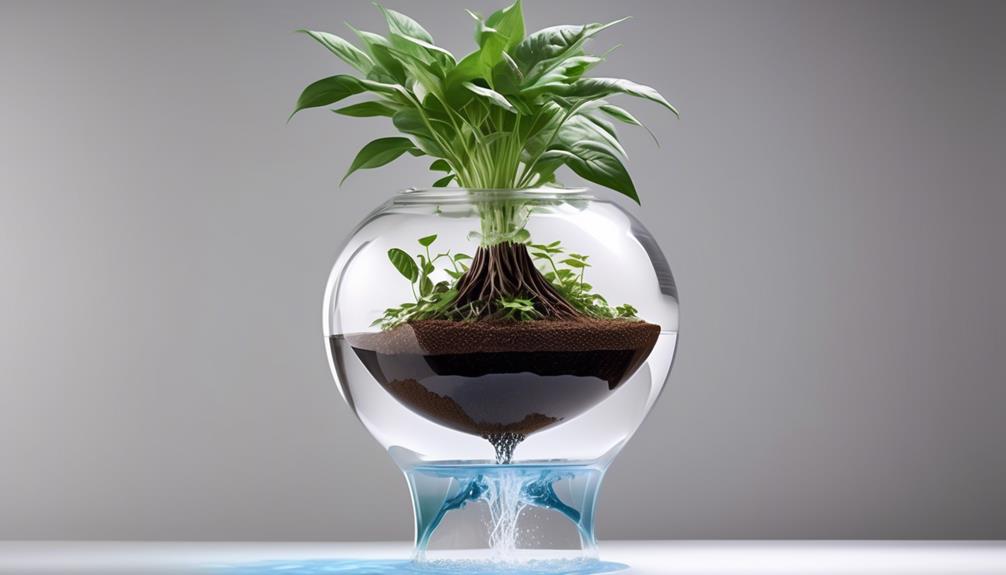
Utilizing a wicking system, self-watering pots draw water from a reservoir and deliver it to the plant's roots as needed, maintaining a consistent level of moisture. The watering mechanism consists of a water reservoir at the bottom of the pot, separated from the soil by a wick. The wick, usually made of a porous material like cotton or nylon, allows water to move upward from the reservoir into the soil through capillary action.
This self-watering technology ensures that the plant's roots have access to water at all times, promoting optimal plant health by preventing both under and overwatering.
Self-watering pots work on the principle of water conservation by minimizing water wastage. The reservoir design reduces the frequency of watering, as the water is gradually released to the plant as needed. This not only saves time and effort for the user but also contributes to sustainable water usage.
Choosing the Right Self-Watering Pot
When selecting a self-watering pot, it's essential to consider the specific needs of the plant and the pot's design to ensure optimal watering efficiency.
The material of the pot plays a crucial role in maintaining the moisture levels. Porous materials such as terracotta allow the soil to breathe, preventing waterlogging, while plastic pots retain moisture better.
The size of the pot is also critical. It should accommodate the plant's roots and provide ample space for water storage without drowning the roots.
Aesthetic design isn't only about visual appeal but also about functionality. Look for pots with a water level indicator, which helps in monitoring the water supply accurately.
Additionally, consider the placement of the pot. Ensure that it's situated in an area with the right light conditions for the specific plant. Direct sunlight can cause the water to evaporate quickly, impacting the self-watering system's effectiveness.
Tips for Using Self-Watering Pots Indoors
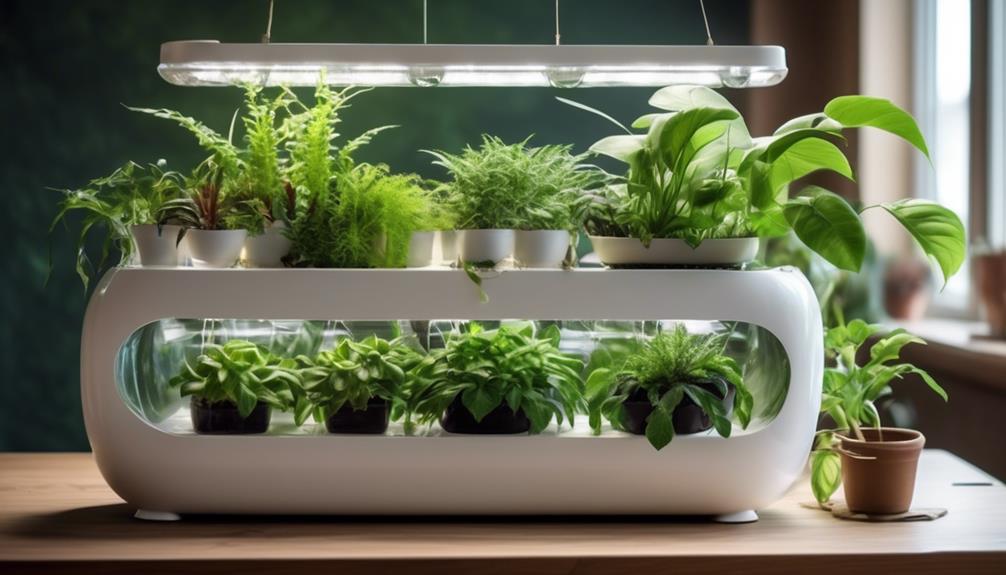
To ensure optimal performance of self-watering pots indoors, it's essential to carefully monitor the water level and adjust the watering frequency according to the specific needs of the plants.
When using self-watering pots indoors, it's important to keep a close eye on the moisture level of the soil. Check the water reservoir regularly to ensure an adequate water supply. Different plants have varying water requirements, so it's crucial to tailor the watering frequency to each plant's individual needs. The self-watering system provides a consistent moisture level, but it's still essential to observe and understand the moisture needs of your plants.
In addition to monitoring the water level, it's crucial to maintain the self-watering system by periodically cleaning the reservoir and wicks to prevent clogs and ensure efficient water distribution. Regularly inspect the potting mix to ensure it's not compacted, which can impede water flow. Adjust the wick position as the plant grows to maintain effective water delivery.
Best Self-Watering Plant Pots Available
Ensuring optimal performance of self-watering pots indoors requires careful consideration of the water level and adjustment of the watering frequency according to the specific needs of the plants.
When it comes to the best self-watering plant pots available, there are several options that cater to different plant care requirements and watering solutions.
One popular choice is the 'African Violet Self-Watering Planter,' designed with a wick system that provides consistent moisture to the plant's roots.
Another excellent option is the 'Ceramic Self-Watering Planter,' which offers a sleek and modern design while effectively regulating water intake for plants.
For larger plants, the 'Self-Watering Hanging Basket' is a practical solution that ensures proper hydration and minimizes the risk of overwatering.
Additionally, the 'Adjustable Self-Watering Spikes' are versatile and can be used with various pot sizes, making them an ideal choice for individuals seeking customizable watering solutions.
These self-watering pots not only simplify plant care but also contribute to healthier and thriving indoor greenery.
Frequently Asked Questions
Are Self-Watering Plant Pots Suitable for All Types of Indoor Plants?
Yes, self-watering plant pots are suitable for a wide variety of indoor plants. They provide the best plants with consistent moisture levels and offer numerous self-watering benefits.
These pots are especially beneficial for plants that require consistent moisture, such as ferns, peace lilies, and spider plants. The self-watering feature helps maintain optimal moisture levels, promoting healthy growth and reducing the risk of over or under watering.
Can Self-Watering Pots Be Used for Outdoor Plants as Well?
Yes, self-watering pots can be used for outdoor plants as well. They offer the benefit of consistent moisture levels, reducing the frequency of watering.
However, they may have limitations for certain outdoor plants that prefer drier soil conditions.
When compared to traditional pots, self-watering pots provide a more controlled watering system.
Understanding the specific needs of the outdoor plant is crucial in determining if a self-watering pot is suitable.
Do Self-Watering Pots Require a Specific Type of Soil for Optimal Performance?
For optimal performance, self-watering pots require a specific type of soil. The soil should be well-draining but also retain moisture to support the self-watering mechanism.
It's important to choose a soil that's compatible with the specific plants you intend to grow in the self-watering pots. Different plants have varying soil requirements, so it's crucial to select the right soil to ensure the health and growth of your indoor plants.
How Often Do Self-Watering Pots Need to Be Refilled With Water?
We've found that self-watering pots offer numerous benefits, such as reducing watering frequency and maintaining plant health.
However, a drawback is the need to refill the water reservoir periodically. To ensure optimal performance, we recommend checking the water levels weekly and refilling as needed.
This practice not only supports the plant's growth but also minimizes the risk of overwatering, promoting a healthy root system.
Are There Any Maintenance Requirements for Self-Watering Plant Pots?
Maintenance requirements for self-watering plant pots include:
- Regular cleaning to prevent clogs and mold.
- Checking water levels and refilling as needed.
- Overfilling can lead to root rot, a common mistake.
Benefits of using self-watering plant pots include:
- Consistent moisture for plants.
Disadvantages may arise from neglecting maintenance.
Following these guidelines ensures healthy plants and efficient use of self-watering pots.
What are the Benefits of Self Watering Plant Pots for Indoor Use?
Indoor self watering pots make plant care effortless. These innovative pots provide a consistent water supply, ensuring that your plants stay hydrated even when you’re away. They help prevent over or under-watering, promoting healthier growth and reducing maintenance. With self watering pots, you can enjoy lush greenery without the hassle.
Conclusion
In conclusion, self-watering plant pots are like the loyal companions of indoor gardening, always there to provide the right amount of hydration for your plants.
Just as a faithful friend knows exactly what you need without you having to ask, these pots intuitively nourish your plants, keeping them healthy and thriving.
With the right choice and proper care, self-watering plant pots can be the dependable allies in your indoor gardening journey.
Self Watering Plant Pots
Do Self Watering Pots Work
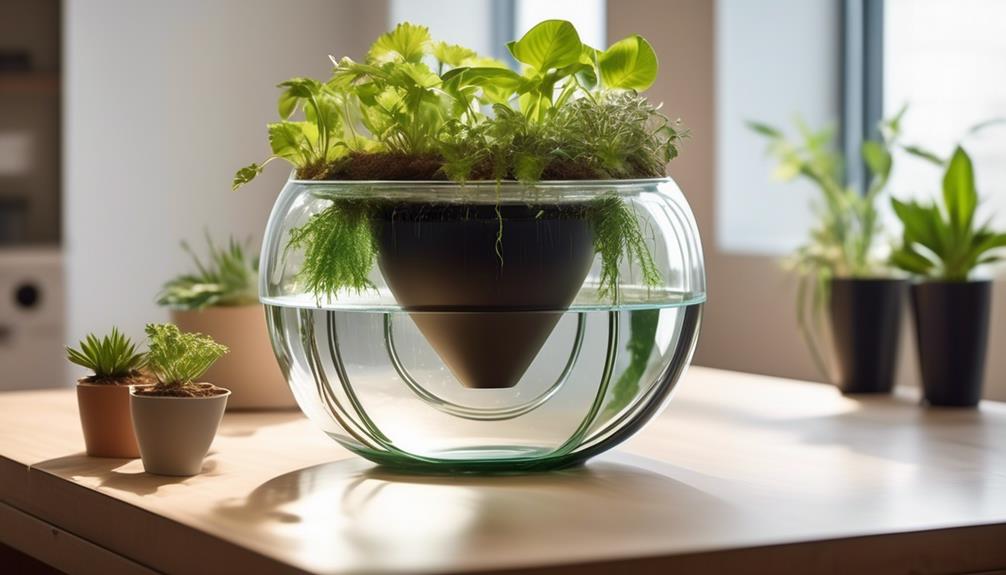
Numerous individuals have come across claims suggesting that self-watering planters serve as a personal gardener for your plants. Yet, are these statements substantiated by evidence? Together, we have explored the scientific foundations behind these sophisticated planting systems, seeking to uncover the truth of their actual effectiveness.
Are they a game-changer for plant enthusiasts or just another gimmick? Join us as we delve into the world of self-watering pots and separate fact from fiction.
Key Takeaways
- Self-watering pots use a reservoir system to supply water to the soil as needed.
- They prevent overwatering by supplying water only when needed, promoting robust root growth and overall plant health.
- Self-watering pots ensure a consistent moisture level in the soil, reducing the risk of over or under-watering.
- Regular monitoring and maintenance are necessary to maintain healthy soil moisture levels and promote optimal plant growth.
The Science Behind Self-Watering Pots
Self-watering pots function by utilizing a reservoir system that supplies water to the soil as needed, promoting optimal moisture levels for plant growth. The watering frequency is determined by the moisture level in the soil, which is monitored by the pot's design. When the soil becomes dry, a wicking mechanism draws water from the reservoir into the soil, ensuring consistent plant hydration. This system prevents overwatering, a common issue with traditional pots, by supplying water only when the plant needs it.
The science behind self-watering pots lies in their ability to maintain a balanced soil moisture level, crucial for plant health. The reservoir system creates a self-regulating environment that allows for the gradual release of water, preventing sudden spikes or drops in moisture. This consistency in plant hydration is essential for promoting robust root growth and overall plant health.
Understanding the intricacies of self-watering pots empowers plant enthusiasts to create an optimal environment for their green companions. By harnessing the scientific principles of water distribution and plant hydration, these pots offer a sophisticated solution for maintaining healthy and thriving plants.
How Self-Watering Pots Function

Utilizing a reservoir system and a wicking mechanism, self-watering pots maintain optimal soil moisture levels by supplying water to the plants as needed.
The watering mechanism explanation includes the following key points:
- Reservoir System: Self-watering pots have a separate reservoir that holds water beneath the soil. This reservoir is designed to store excess water, preventing the soil from becoming waterlogged while ensuring a constant supply of moisture to the plant's roots.
- Wicking Mechanism: A wick, usually made of fabric or rope, extends from the reservoir into the soil. Through capillary action, the wick draws water from the reservoir and delivers it directly to the plant's roots, ensuring a steady and consistent supply of water.
- Self-Watering Pot Maintenance: To maintain the effectiveness of self-watering pots, it's essential to regularly monitor the water level in the reservoir and refill it as needed. Additionally, periodic checks of the wick to ensure it's clean and unobstructed are crucial for optimal function.
Understanding the intricacies of the watering mechanism and the necessary maintenance allows for the efficient use of self-watering pots, ensuring healthy and thriving plants.
Benefits of Self-Watering Pots
With the understanding of how self-watering pots function and their maintenance requirements in mind, we can now explore the numerous benefits that these innovative containers offer for plant health and growth.
Self-watering pots provide exceptional watering efficiency by ensuring a consistent moisture level in the soil, which is crucial for plant growth. These pots utilize a reservoir system that allows plants to draw water as needed, reducing the risk of over or under-watering. This efficient water delivery system also minimizes water wastage, making self-watering pots an environmentally friendly choice.
Another benefit of self-watering pots is the flexibility they offer in plant selection. The consistent moisture levels created by these pots make them suitable for a wide range of plants, including those with specific watering needs. This opens up opportunities to cultivate a variety of plants, from moisture-loving ferns to drought-tolerant succulents, in the same type of container.
Additionally, the reduced frequency of watering required by self-watering pots makes them ideal for busy individuals or those with limited mobility.
Factors Affecting Pot Effectiveness
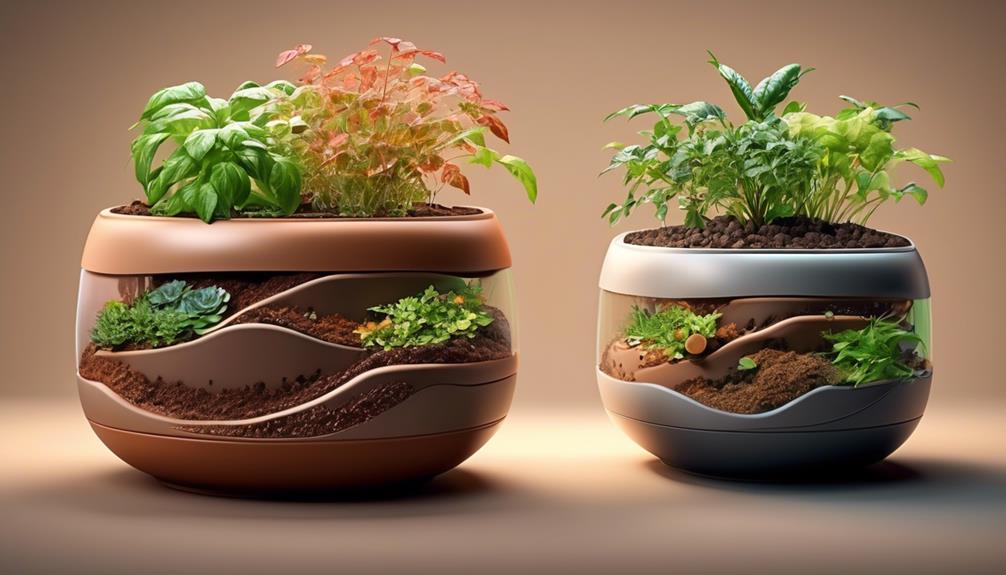
Considering the various factors that can influence the effectiveness of self-watering pots, it's essential to evaluate the material composition of the pot itself. The material of the pot can significantly impact its ability to maintain proper moisture levels and support plant growth.
Factors affecting pot effectiveness include:
- Porosity: The porosity of the pot material determines how much water it can hold and how quickly it can release moisture to the plant's roots. High porosity materials like terracotta may require more frequent refilling, while less porous materials like plastic can retain moisture for longer periods.
- Insulation: The insulating properties of the pot material can affect the soil temperature, which in turn impacts plant growth. Materials that provide better insulation can help maintain optimal soil temperatures, promoting healthier root development and overall plant vigor.
- Durability: The longevity and structural integrity of the pot material are crucial for sustained watering efficiency. Durable materials can withstand environmental stressors and ensure the long-term functionality of the self-watering system.
Understanding these factors is essential for maximizing pot effectiveness, promoting healthy plant growth, and optimizing watering efficiency. Selecting the right material for a self-watering pot can make a significant difference in maintaining a thriving and sustainable plant environment.
Choosing the Right Potting Mix
When choosing the right potting mix for self-watering pots, we need to consider its moisture retention and nutrient availability.
The potting mix should be able to hold onto moisture for extended periods to support the self-watering system.
Additionally, the mix should provide essential nutrients for the plant's growth and development.
Potting Mix Moisture Retention
Choosing the right potting mix is crucial for ensuring optimal moisture retention in self-watering pots. When it comes to potting mix moisture retention, consider the following:
- Watering frequency: The composition of the potting mix directly impacts how often you need to water your plants. A mix that retains moisture well can reduce the frequency of watering, providing a more stable environment for plant roots.
- Evaporation rates: The ability of the potting mix to retain moisture also affects evaporation rates. A high-quality mix with good moisture retention properties can slow down evaporation, ensuring that the plant roots have consistent access to water.
- Soil structure: The physical structure of the potting mix plays a significant role in moisture retention. Look for mixes with a balanced ratio of organic matter, such as peat or coconut coir, and inorganic materials like perlite or vermiculite to create an ideal environment for moisture retention.
Nutrient Availability in Mix
To ensure optimal nutrient availability in the potting mix, it is essential to select a blend that provides a balanced array of essential plant nutrients without compromising moisture retention properties. When choosing a potting mix, consider the nutrient content and the watering frequency required for your specific plants. The table below outlines key nutrients and their functions, aiding in the selection of an appropriate potting mix for your plants.
| Nutrient | Function |
|---|---|
| Nitrogen | Essential for leaf growth |
| Phosphorus | Promotes root development |
| Potassium | Aids overall plant health |
| Calcium | Supports cell structure |
| Magnesium | Essential for photosynthesis |
Understanding Water Reservoirs
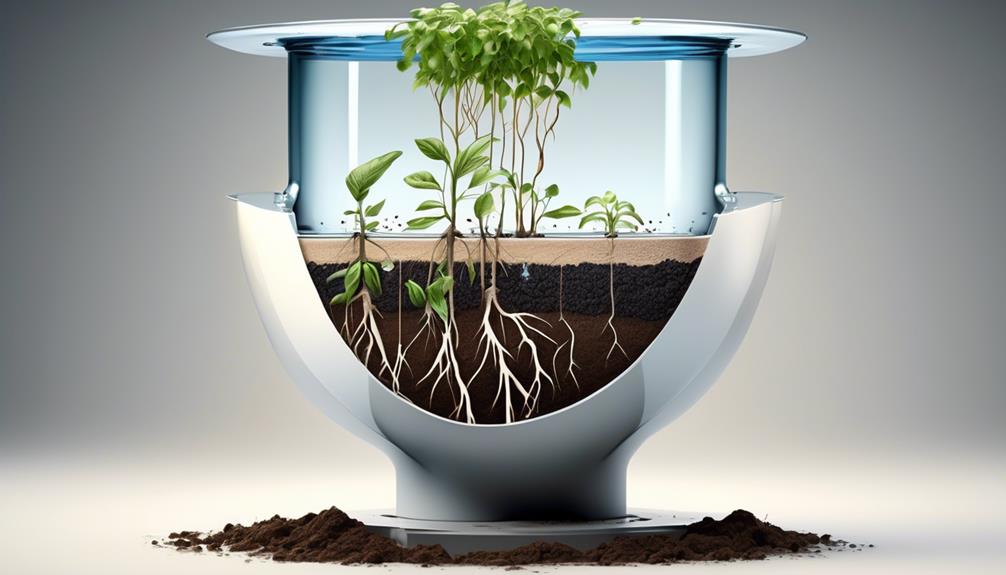
In self-watering pots, the water reservoir is a key component designed to provide a consistent and regulated supply of water to the plant's roots. Understanding the function and importance of water reservoirs is crucial for maximizing the benefits of self-watering pots.
Here are three key points to consider:
- Watering Frequency: The water reservoir in self-watering pots helps to regulate watering frequency by providing a continuous supply of water to the plant's roots. This can be particularly beneficial for plants that require consistent moisture levels, as it helps to prevent overwatering or underwatering, leading to healthier root systems.
- Root Health: The design of the water reservoir promotes healthier root development by allowing the roots to access water as needed. This constant access to water encourages the roots to grow deeper into the growing medium, leading to a stronger and more robust root system. Additionally, the regulated moisture levels can help prevent root rot and other water-related issues.
- Moisture Regulation: The water reservoir acts as a buffer against fluctuations in moisture levels, providing a more stable environment for the plant's roots. This stability can enhance overall plant health and resilience, especially during hot or dry periods.
Understanding the role of water reservoirs in self-watering pots is essential for harnessing their full potential and promoting optimal plant growth.
Maintenance Tips for Self-Watering Pots
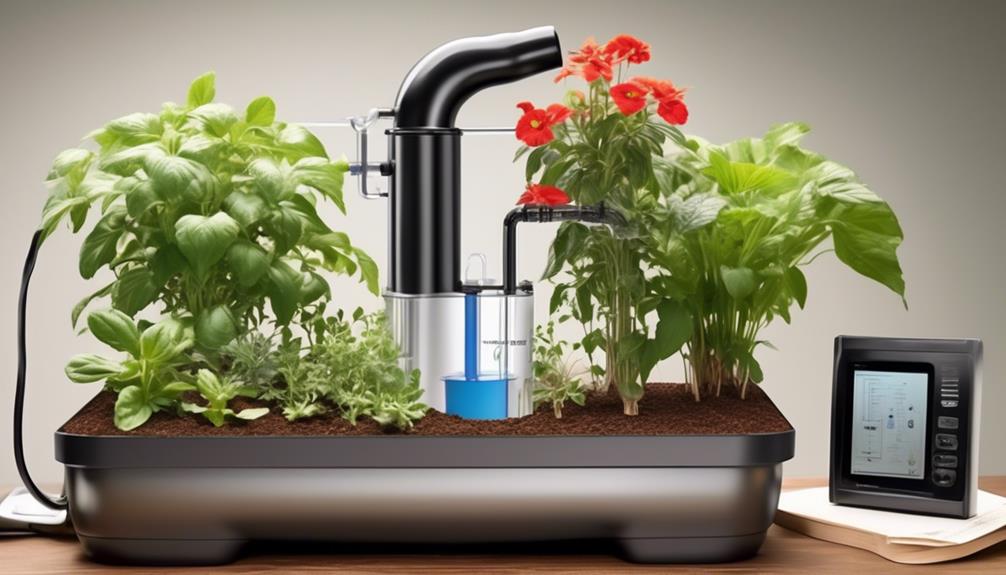
When maintaining self-watering pots, it is important to regularly monitor the water levels in the reservoir to ensure consistent and adequate hydration for the plants. This involves checking the water level indicator or physically inspecting the reservoir to avoid overfilling or allowing it to run dry. Additionally, understanding the watering frequency and soil moisture requirements of different plants is crucial for effective maintenance. Here are some essential maintenance tips for self-watering pots:
| Maintenance Tips | Details | Importance |
|---|---|---|
| Monitor Water Levels | Check the water level indicator or reservoir regularly | Ensures proper hydration |
| Adjust Watering Frequency | Adapt to the specific needs of different plant species | Prevents over/under watering |
| Check Soil Moisture | Use a moisture meter or visually inspect the soil | Ensures optimal growing conditions |
Common Myths Debunked

Debunking common myths surrounding the effectiveness of self-watering pots requires a critical examination of their functionality and practical implications.
Here are three misconceptions about self-watering pots that need to be addressed:
- Self-watering pots overwater plants: One common misconception is that self-watering pots lead to overwatering. In reality, these pots have a reservoir that holds excess water, preventing the soil from becoming waterlogged. The wicking system draws water up into the soil as needed, providing plants with consistent moisture levels without the risk of overwatering.
- Plants become dependent on self-watering pots: Some believe that plants grown in self-watering pots become reliant on the continuous water supply, making them less resilient. However, self-watering pots promote healthy root growth by allowing plants to access water as needed. This actually helps plants develop stronger root systems and enhances their ability to withstand periods of drought.
- Self-watering pots are only suitable for certain plants: Another misconception is that self-watering pots are limited in their practical applications. In fact, these pots are suitable for a wide range of plants, including vegetables, herbs, and flowering plants, making them versatile options for gardeners and indoor plant enthusiasts.
Comparing Self-Watering Vs. Traditional Pots
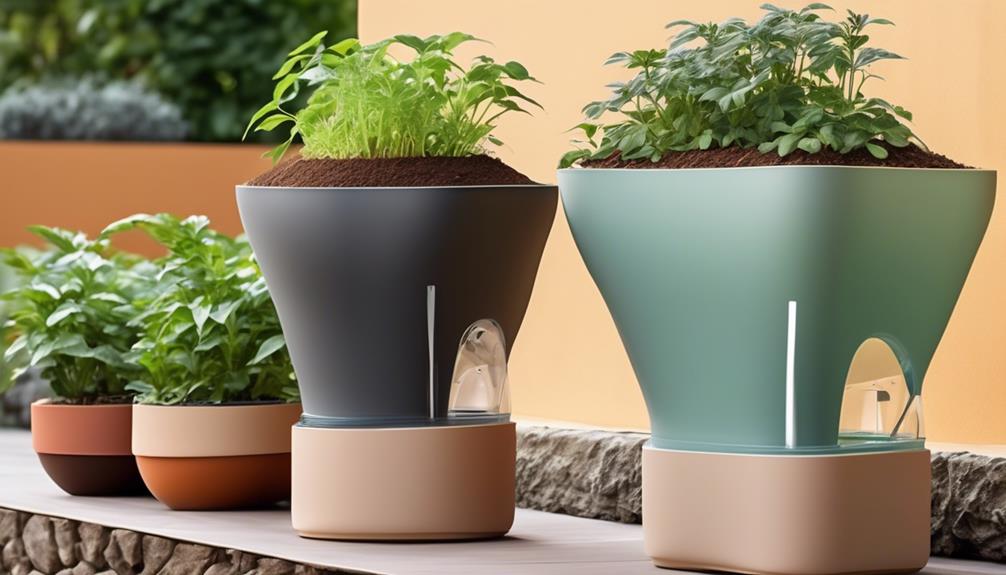
When comparing self-watering pots with traditional pots, it's crucial to consider their watering efficiency, plant health benefits, and maintenance convenience.
By examining these three key points, we can gain a comprehensive understanding of the effectiveness of self-watering pots in comparison to traditional ones.
This analysis will provide valuable insights into the practical implications of using self-watering pots for plant cultivation.
Watering Efficiency Comparison
In evaluating the watering efficiency of self-watering pots versus traditional pots, it's essential to consider key factors such as water usage, moisture retention, and plant hydration.
Watering frequency: Self-watering pots generally require less frequent watering due to their reservoir system, which provides a consistent water supply to the plants.
Plant growth: Studies have shown that self-watering pots can promote better plant growth due to their ability to provide a steady moisture level, which is crucial for root development and overall plant health.
Water conservation: Self-watering pots have been found to be more water-efficient compared to traditional pots, as they minimize water wastage through evaporation and drainage.
These factors highlight the superior watering efficiency of self-watering pots, making them a compelling option for plant enthusiasts seeking optimal hydration and growth for their plants.
Plant Health Benefits
Considering the superior watering efficiency of self-watering pots previously discussed, we can now examine the specific plant health benefits associated with using these pots compared to traditional ones. Self-watering pots offer several advantages for plant growth and overall health. The table below summarizes the key plant health benefits of self-watering pots compared to traditional pots in terms of watering techniques.
| Plant Health Benefits | Self-Watering Pots | Traditional Pots |
|---|---|---|
| Consistent Moisture Levels | Maintains optimal moisture levels, promoting steady plant growth | Watering frequency may result in fluctuations in soil moisture, impacting plant health |
| Reduced Risk of Overwatering | Self-regulating systems prevent waterlogging, reducing the risk of root rot | Manual watering can lead to overwatering, which is detrimental to plant health |
| Enhanced Nutrient Uptake | Efficient watering ensures better nutrient absorption, supporting overall plant vitality | Inconsistent watering may hinder nutrient uptake, affecting plant growth |
Self-watering pots provide a controlled environment that fosters healthier plant growth through consistent moisture levels, reduced risk of overwatering, and improved nutrient uptake.
Maintenance and Convenience
Comparing self-watering pots to traditional ones reveals significant differences in maintenance and convenience, which impact the overall care and management of potted plants.
- Watering Frequency:
Self-watering pots reduce the frequency of watering as they provide a reservoir for the plant to draw from. This contrasts with traditional pots that require more frequent monitoring and watering due to their standard drainage system.
- Maintenance Schedule:
Self-watering pots generally require less frequent maintenance as their design minimizes water evaporation and nutrient loss. On the other hand, traditional pots necessitate a more rigid maintenance schedule, often requiring daily checks for water and nutrient levels.
- Convenience:
The convenience of self-watering pots is evident in their ability to sustain plants for longer periods without constant supervision, making them ideal for individuals with busy schedules or those seeking to minimize plant care efforts.
Understanding the differences in maintenance and convenience between self-watering and traditional pots is crucial in determining the most suitable option for individual plant care needs.
Best Plants for Self-Watering Pots
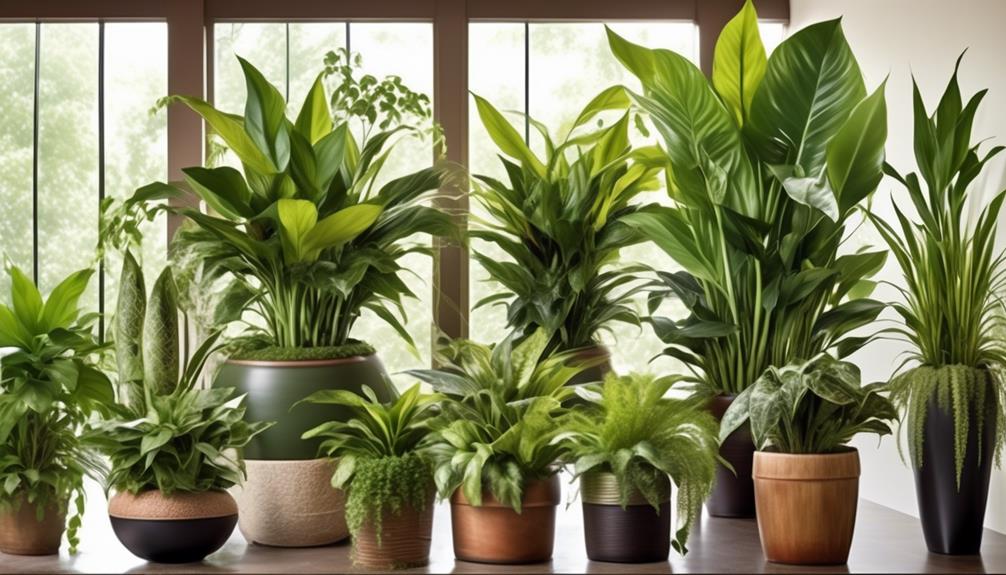
When selecting plants for self-watering pots, it's essential to choose species that are well-suited to consistent moisture and thrive in a more controlled watering environment. Best indoor plants for self-watering pots include peace lilies, spider plants, pothos, and snake plants. These plants are adaptable to indoor conditions and are known for their ability to thrive in consistently moist soil.
Peace lilies, for example, are resilient and can handle a variety of light conditions, making them suitable for different indoor environments. Spider plants are also well-suited for self-watering pots due to their ability to tolerate evenly moist soil. Pothos, with their heart-shaped leaves, and snake plants, known for their hardiness and air-purifying qualities, are also excellent choices for self-watering pots.
When engaging in container gardening, it's important to consider the specific needs of the chosen plants. Selecting plants that naturally prefer consistent moisture ensures better success with self-watering pots. Additionally, it's crucial to monitor the soil moisture levels regularly to adjust the watering system as needed, providing the optimal conditions for the chosen plant species.
Addressing Potential Drawbacks
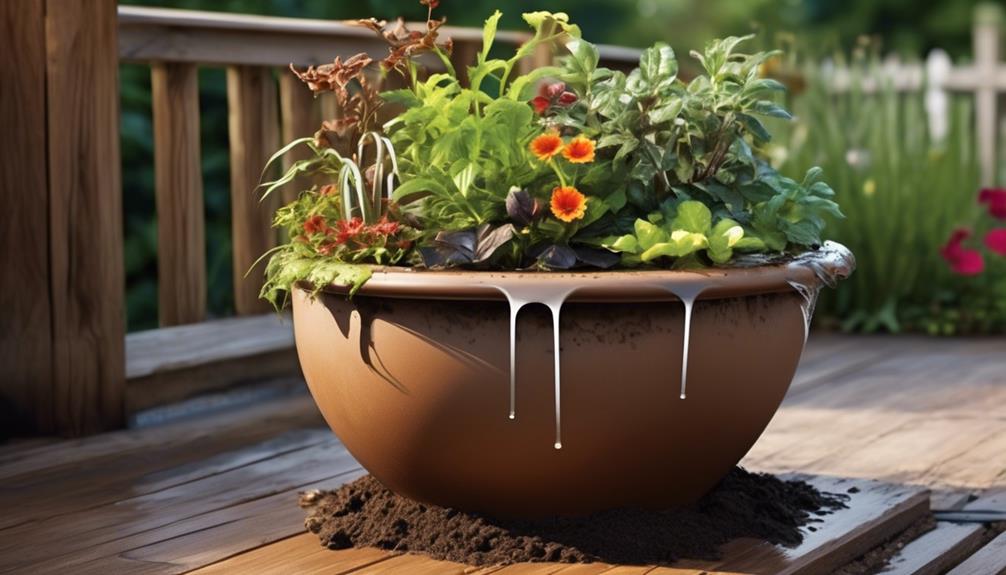
When using self-watering pots, it's important to monitor soil moisture levels to ensure the plant's health and growth. One potential drawback is the possibility of overwatering, which can lead to root rot and other issues.
Additionally, depending on the plant species, some may have specific watering needs that may not align with the self-watering pot's capabilities.
Soil Moisture Levels
While self-watering pots have been designed to maintain optimal soil moisture levels, it's important to address potential drawbacks that may affect their effectiveness.
- Watering Frequency: The self-watering system may lead to overwatering if not monitored closely, potentially causing root rot and other issues.
- Soil Moisture and Plant Growth: In certain cases, the soil moisture levels in self-watering pots may not be evenly distributed, leading to uneven plant growth and nutrient uptake.
- Maintenance Requirements: These pots may require regular cleaning and maintenance to prevent mold growth, algae, and mineral buildup, which can affect soil moisture levels and plant health.
Understanding these factors is crucial for maximizing the benefits of self-watering pots while mitigating their potential drawbacks. Regular monitoring and adjustments can help maintain healthy soil moisture levels and promote optimal plant growth.
Plant Health and Growth
To address potential drawbacks related to plant health and growth in self-watering pots, careful consideration of soil moisture distribution and maintenance requirements is essential. While self-watering pots can provide a consistent water supply, improper watering can lead to waterlogging and root rot, affecting plant health.
Additionally, the reliance on self-watering systems may result in neglecting other essential aspects of plant care, such as monitoring soil nutrition and addressing specific watering needs of different plant species. It's crucial to understand that while self-watering pots can be beneficial, they don't eliminate the need for regular monitoring and maintenance.
Furthermore, soil nutrition plays a critical role in plant growth, and the automatic watering system may not always provide sufficient nutrients. Therefore, supplementing with appropriate fertilizers is necessary to ensure optimal plant health and growth in self-watering pots.
Tips for Optimal Plant Health

Implementing a consistent watering schedule and monitoring soil moisture levels are crucial for maintaining optimal plant health in self watering pots. To ensure the best conditions for your plants, here are three essential tips to consider:
- Optimal Watering Schedule: Establishing a regular watering routine is essential for plant health. Self watering pots can sometimes lead to overwatering, so it's important to adjust the watering schedule based on the specific needs of each plant. Factors such as plant type, pot size, and environmental conditions should be taken into account when determining the frequency of watering.
- Proper Drainage Techniques: While self watering pots can help regulate moisture, it's still important to ensure proper drainage. This can be achieved by using a well-draining potting mix and monitoring the water level in the reservoir to prevent waterlogging. Adequate drainage is crucial for preventing root rot and other water-related issues.
- Soil Moisture Monitoring: Regularly check the moisture levels in the potting mix to avoid both overwatering and underwatering. Utilize moisture meters or simply feel the soil to gauge its moisture content. Understanding the moisture needs of your plants is vital for maintaining their overall health and vitality.
DIY Self-Watering Pot Options
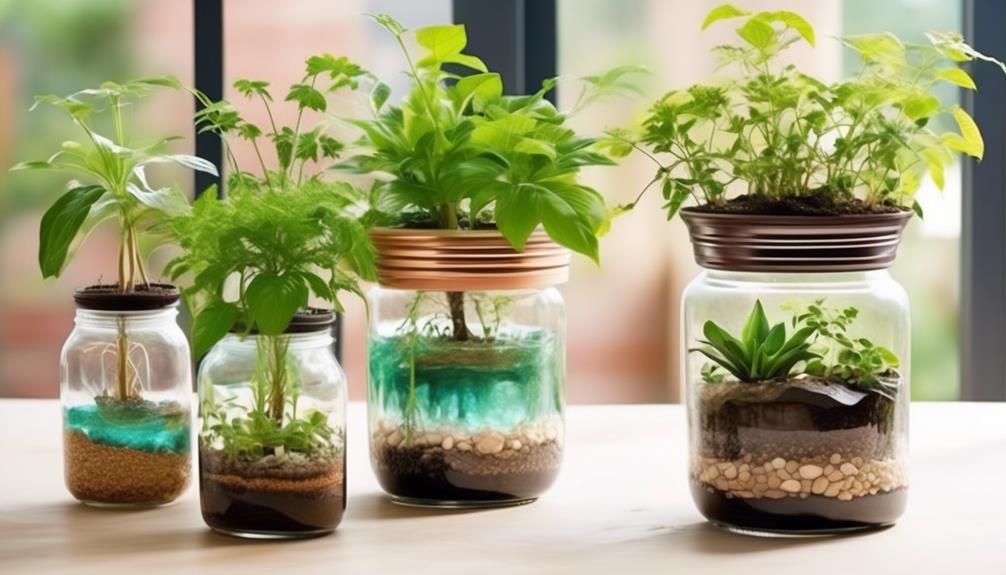
When considering DIY self-watering pot options, it's important to understand the benefits of creating one yourself. This includes the ability to customize the size and design of the pot to fit your specific needs. Additionally, DIY self-watering pots can be more cost-effective compared to purchasing pre-made ones.
Next, it's essential to know the materials required for the project. This typically includes a plastic container or pot with a lid or reservoir, a wicking material such as cotton or felt, and a water source such as a tube or bottle. It's also helpful to have a drill or other tools for creating holes in the pot for water flow.
Finally, having a step-by-step guide for construction is crucial. This can be found in various online resources or gardening books. The guide will walk you through the process of assembling the pot, including drilling holes, placing the wicking material, and connecting the water source. Following the guide ensures that the self-watering pot is built correctly and functions effectively.
Benefits of DIY
In our exploration of DIY self-watering pot options, it's essential to consider the practical benefits and potential drawbacks of creating your own self-watering system for plants.
When it comes to the benefits of the do-it-yourself approach, there are several key advantages to consider:
- Customization: DIY self-watering pots allow for customization based on the specific needs of different plants, ensuring optimal growing conditions.
- Cost-Effectiveness: Creating your own self-watering system can be a more budget-friendly option compared to purchasing commercially available self-watering pots.
- Environmental Impact: By using recycled materials or repurposing existing containers for DIY self-watering pots, you can contribute to reducing waste and minimizing your environmental footprint.
These benefits highlight the practical advantages of taking a DIY approach to self-watering pots, offering both customization and sustainability.
Materials Required
To create a DIY self-watering pot, one must gather specific materials that are essential for constructing an effective and efficient self-watering system for plants. The key materials needed for this DIY project include a water reservoir, a potting container, a wicking mechanism, and a potting mix. The benefits of using self-watering pots are numerous, including consistent moisture levels, reduced water wastage, and improved plant health. When selecting the potting mix, it is important to choose options with excellent moisture retention properties such as peat moss, coconut coir, or vermiculite. These materials aid in maintaining the proper balance of air and water in the soil, promoting healthy root growth. Here's a table outlining the essential materials required for a DIY self-watering pot:
| Materials | Purpose |
|---|---|
| Water reservoir | Stores water for self-watering system |
| Potting container | Holds the plant and water reservoir |
| Wicking mechanism | Draws water from reservoir to soil |
Step-By-Step Guide
Utilizing the essential materials outlined in the previous subtopic, we can begin constructing a DIY self-watering pot to effectively maintain plant moisture levels and promote healthy root growth. Follow these steps to create your own self-watering pot:
- Prepare the Reservoir:
Drill a hole near the bottom of the outer container for water access and place a water reservoir, such as a plastic bottle, inside.
- Insert the Wicking Material:
Thread a piece of cotton rope through the hole into the soil, allowing it to draw water from the reservoir to the plant's roots.
- Fill with Soil and Plant:
Fill the outer container with soil, ensuring the wick is in contact with it, and plant your chosen greenery.
The Environmental Impact
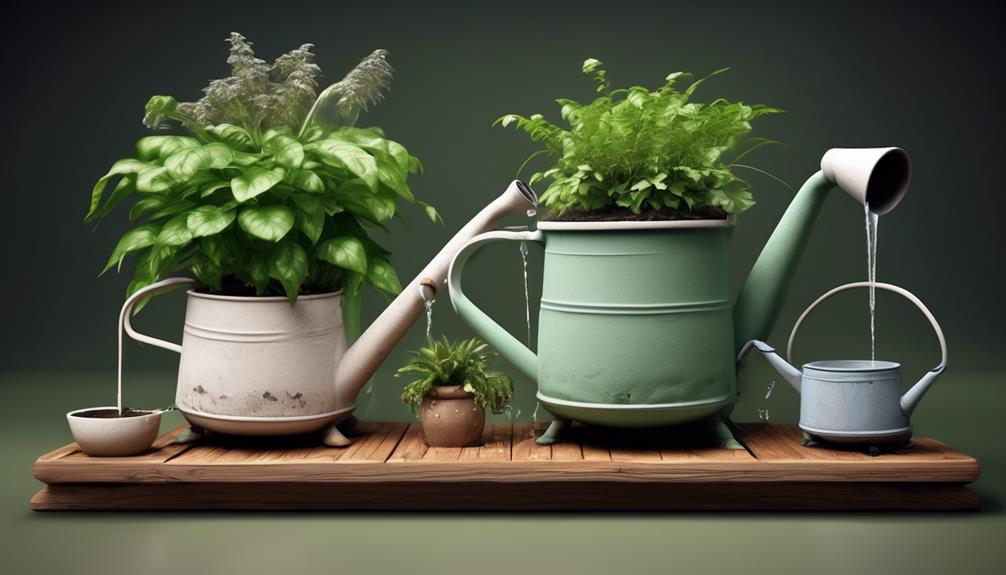
While the concept of self-watering pots may seem promising for reducing water usage and promoting plant growth, it's essential to carefully evaluate their environmental impact to determine their overall sustainability.
The environmental impact of self-watering pots must be considered in terms of water conservation and the materials used in their construction. These pots have the potential to conserve water by reducing evaporation and preventing water runoff. However, the production of self-watering pots involves the use of plastics and other materials that may have a negative environmental impact.
Additionally, the longevity and recyclability of these pots must be taken into account to assess their overall environmental footprint.
To accurately evaluate the environmental impact of self-watering pots, a life cycle assessment considering their production, usage, and disposal is necessary. This assessment should include factors such as energy consumption, greenhouse gas emissions, and waste generation associated with these pots.
Furthermore, the potential benefits of using self-watering pots for water conservation must be weighed against their environmental drawbacks to make an informed decision regarding their sustainability.
Real User Experiences
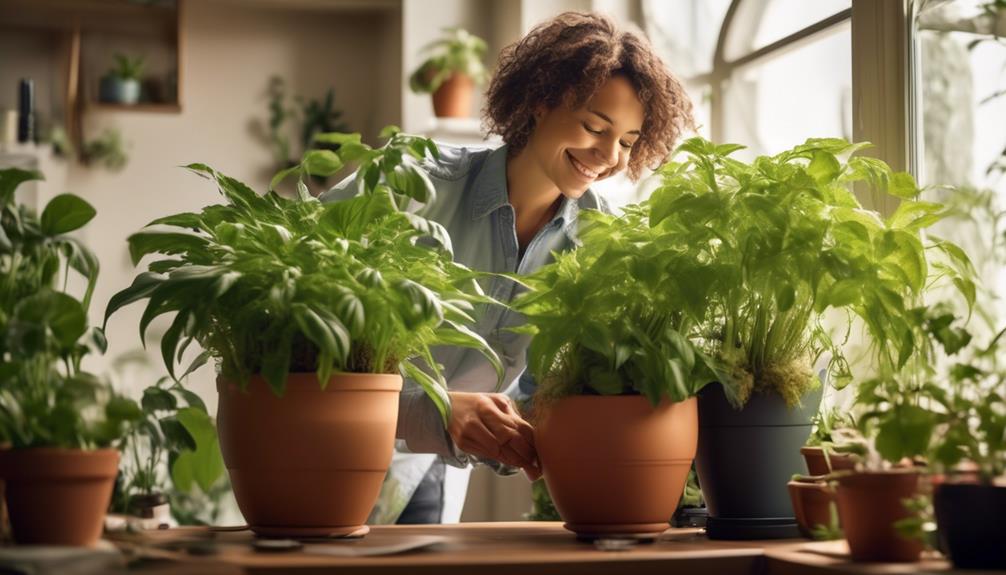
Considering the potential environmental impacts of self-watering pots, users have reported a range of experiences with these innovative planters. Our analysis of real user experiences with self-watering pots reveals the following insights:
- User Satisfaction and Watering Frequency:
Many users have expressed satisfaction with self-watering pots, noting that these planters have significantly reduced the frequency of watering required. The convenience of not having to water plants daily has been a major factor in user satisfaction. However, some users have reported the need to monitor the water level in the reservoir regularly to ensure optimal plant hydration.
- Plant Growth and Water Consumption:
Users have observed improved plant growth when using self-watering pots. The consistent moisture levels provided by these pots have resulted in healthier and more vibrant plants. Additionally, users have noted that self-watering pots tend to consume water more efficiently, as the reservoir system prevents excess water loss through evaporation and drainage.
- Overall Convenience and Practicality:
A common sentiment among users is the convenience and practicality of self-watering pots, especially for individuals with busy schedules or those who may not have a green thumb. The ease of maintaining plants in self-watering pots has been a key factor in their widespread adoption.
Frequently Asked Questions
Can Self-Watering Pots Be Used for Outdoor Gardening?
Yes, self-watering pots can be used for outdoor gardening. They provide a convenient and efficient way to maintain soil moisture, which is crucial for plant health.
These watering systems reduce the frequency of manual watering, making outdoor maintenance more manageable. By regulating water intake, self-watering pots help create an optimal growing environment for plants.
Are Self-Watering Pots Suitable for All Types of Plants, Including Succulents and Cacti?
When caring for succulents, it's key to maintain optimal watering frequency. Self-watering pots can provide steady moisture, but suitability varies by plant type.
Succulents, with low water needs, may thrive in these pots, but proper drainage is crucial.
We'll analyze whether self-watering pots are suitable for all plant types and discuss succulent care, including watering frequency, to provide a comprehensive understanding of their effectiveness for different species.
How Long Do Self-Watering Pots Typically Last Before Needing to Be Replaced?
Self-watering pots typically last a long time before needing replacement, depending on water consumption and maintenance. The durability and cost-effectiveness of these pots make them a practical choice.
Regularly checking the water level and adhering to a maintenance schedule can extend their lifespan. Understanding the specific needs of different plants is crucial for maximizing the benefits of self-watering pots.
These factors contribute to the overall effectiveness and longevity of self-watering pots.
Can Self-Watering Pots Be Used in Conjunction With Traditional Watering Methods?
Yes, self-watering pots can be used alongside traditional watering methods to enhance watering efficiency and maintain optimal soil moisture.
This dual approach can support robust plant growth and encourage healthy root development.
Are Self-Watering Pots Safe for Use Around Pets and Children?
Yes, self-watering pots are safe for use around pets and children. Safety concerns are minimal due to the design that prevents water spillage and minimizes the risk of accidental ingestion.
Their effectiveness comparison to traditional watering methods also shows promising results.
It's important to note that proper maintenance and supervision are still necessary, but overall, these pots provide a convenient and secure option for households with pets and children.
Are Self Watering Pots Effective for Keeping Plants Hydrated?
Yes, self watering pots effectiveness varies depending on the plant and environmental factors. These pots can help maintain proper hydration levels by providing consistent moisture, but it’s important to monitor soil moisture and adjust watering frequency accordingly. In general, self watering pots can be effective at keeping plants hydrated.
Conclusion
In conclusion, self-watering pots are a viable option for maintaining the health of your plants.
While some may be skeptical of their effectiveness, the science behind self-watering pots and the positive real user experiences demonstrate their ability to provide consistent hydration to your plants.
By understanding the factors that affect pot effectiveness and choosing the right potting mix, you can ensure optimal plant health and growth with self-watering pots.
Self Watering Plant Pots
Self Watering Plant Pots
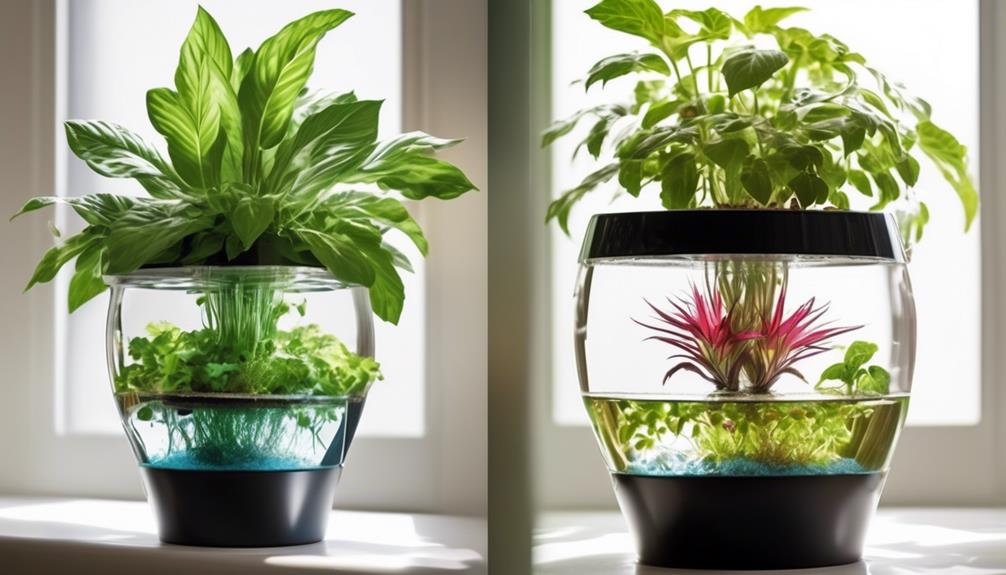
Envision a thriving, lush green plant – what do you picture? For many, it’s the vivid image of rich green leaves alongside vibrant, colorful blooms.
But achieving that picture-perfect plant can be a struggle, especially when it comes to watering. That's where self-watering plant pots come in. They offer a solution that promises to simplify the task of keeping our plants healthy and hydrated.
But do they really work? Are they worth the investment? Let's explore the benefits, best practices, and potential pitfalls of self-watering plant pots to find out.
Key Takeaways
- Consistent moisture level prevents underwatering and overwatering
- Promotes stronger root development and overall growth
- Efficient water use and improved plant health
- Minimizes water runoff and evaporation
Benefits of Self-Watering Plant Pots
Self-watering plant pots offer numerous advantages, including efficient water use and improved plant health. When it comes to improving plant health, self-watering pots provide a consistent moisture level, preventing both underwatering and overwatering. This is particularly beneficial for busy individuals or those new to gardening who may not have the time or experience to monitor plant hydration regularly. The self-regulating system ensures that plants receive the right amount of water, promoting stronger root development and overall growth.
In addition to improving plant health, self-watering pots also contribute to water conservation. By minimizing water runoff and evaporation, these pots maximize the use of water, making them an eco-friendly choice. The reservoir system reduces water waste, making it an efficient option for those who are mindful of sustainable practices. This not only benefits the individual plant but also aligns with a larger goal of environmental responsibility.
Choosing the Right Self-Watering Pot
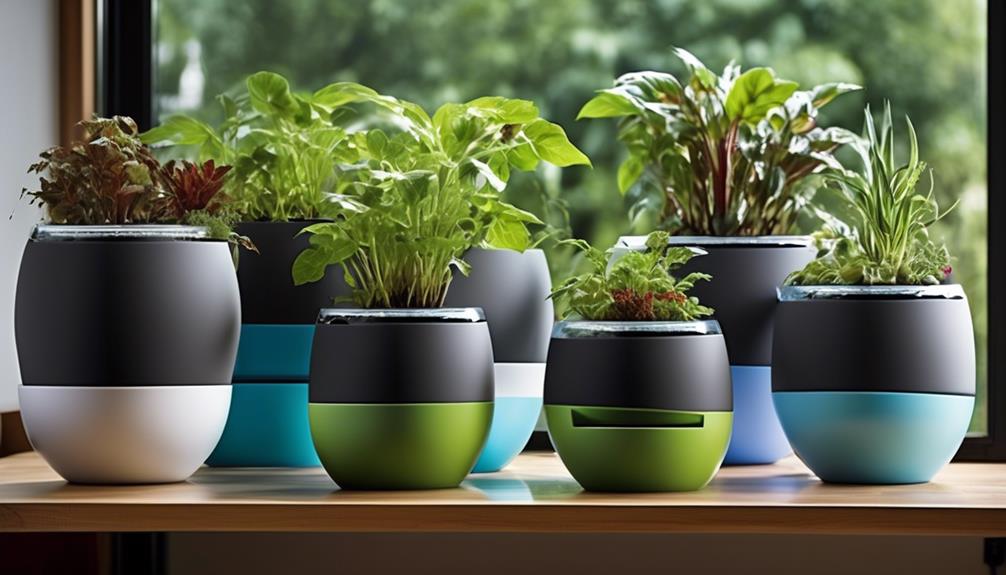
When selecting a self-watering pot for your plants, consider the size and material of the pot to ensure optimal growth and water efficiency. Understanding the self-watering pot mechanisms and selecting the best plants for self-watering pots is essential for successful indoor or outdoor gardening. To help you make an informed decision, we've provided a table below summarizing the key factors to consider when choosing the right self-watering pot.
| Factors to Consider | Recommendation |
|---|---|
| Size | Choose a pot that accommodates the plant's root system and allows for growth. |
| Material | Opt for durable materials such as plastic, ceramic, or terracotta, depending on the plant's needs. |
| Mechanisms | Look for pots with a reliable water reservoir and aeration system to prevent overwatering. |
| Plant Selection | Select plants that thrive in self-watering pots, such as herbs, succulents, and certain indoor plants. |
| Maintenance | Consider the ease of maintenance and accessibility for refilling the reservoir. |
Setting Up Your Self-Watering Pot
After selecting the appropriate self-watering pot based on size, material, and mechanisms, the next step is to effectively set it up for optimal plant growth and water efficiency.
Start by filling the water reservoir with clean water and add the water level indicator.
Then, choose the right soil mix, ensuring it's well-draining to prevent waterlogging. Fill the pot with the soil mix, leaving enough space for the plant's root ball.
Once the plant is in place, water the soil thoroughly from the top to help the roots establish. This initial watering will also help kick-start the self-watering mechanism.
Monitoring the soil moisture is crucial. Check the water level indicator regularly to gauge when it's time to refill the reservoir. Adjust the watering frequency based on the plant's needs and environmental conditions.
Additionally, periodically check the soil moisture to ensure it remains within the optimal range for your specific plant.
Maintaining Self-Watering Plant Pots
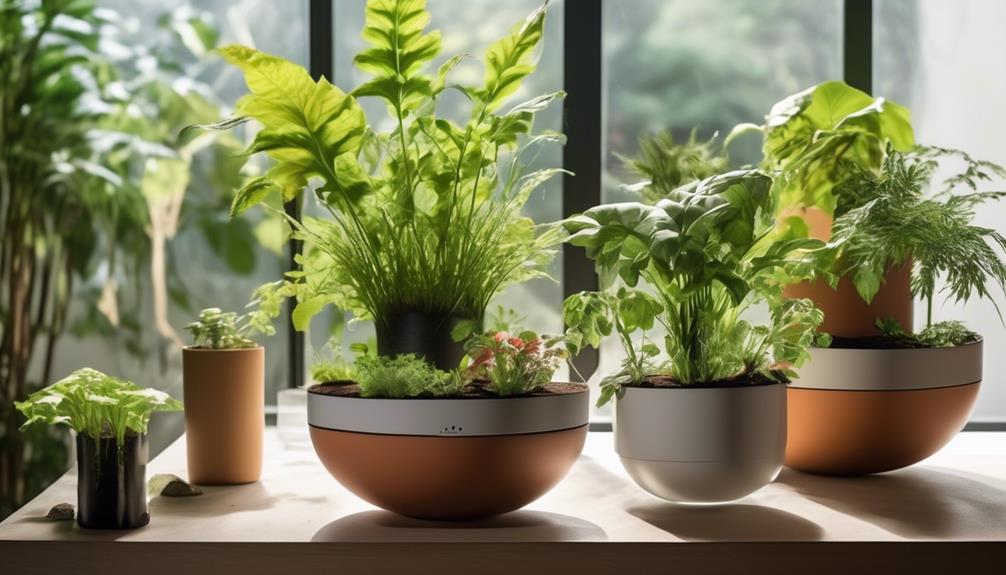
To effectively maintain self-watering plant pots, we closely monitor the soil moisture and regularly refill the water reservoir as needed to ensure optimal conditions for plant growth. Monitoring soil moisture is crucial; we do this by inserting a finger into the soil to the depth of the plant's root zone. If the soil feels dry, it's time to refill the water reservoir.
Additionally, we inspect the drainage system to prevent waterlogging, which can lead to root rot. We also clean the watering system regularly to prevent clogs and ensure proper water flow to the soil.
Troubleshooting common issues in self-watering plant pots involves checking for any blockages in the watering system, ensuring the soil isn't overly saturated, and adjusting the water level based on the plant's needs. It's important to address any issues promptly to maintain the health of the plants.
Maximizing plant growth in self-watering pots requires consistent monitoring and maintenance. By staying proactive and attentive to the plant's needs, we can ensure that the self-watering system functions optimally, providing the ideal environment for plant growth and thriving.
Tips for Successful Self-Watering Pot Usage
We have found that selecting the right soil mix is crucial for successful self-watering pot usage, as it directly impacts the plant's ability to absorb water and nutrients effectively. When using self-watering pots, it's essential to use a well-draining soil mix to prevent waterlogging, which can lead to root rot and other issues. A mix containing peat, pine bark, and perlite provides good aeration and moisture retention, promoting healthy root growth. Additionally, adding a layer of mulch on top of the soil can help reduce evaporation and maintain soil moisture.
Troubleshooting common issues with self-watering pots involves regularly checking the water level indicator and adjusting as needed. If the water level drops rapidly, it may indicate that the plant requires more water, or the potting mix is too dry. On the other hand, if the water level remains consistently high, it might indicate overwatering or poor soil drainage.
Maximizing efficiency in self-watering pots includes periodic cleaning of the watering system to prevent clogs and algae buildup, as well as ensuring that the pot is placed in an area with adequate light and airflow for optimal plant growth.
Frequently Asked Questions
Can Self-Watering Plant Pots Be Used for All Types of Plants, Including Succulents and Cacti?
Absolutely! When it comes to plant care, watering solutions are crucial.
Self-watering plant pots can be used for a variety of plants, including succulents and cacti. These pots provide consistent moisture levels, which is essential for the health and growth of these plants.
The self-watering feature ensures that these plants receive the right amount of water without the risk of overwatering, making it an effective solution for their specific watering needs.
Are Self-Watering Plant Pots Suitable for Outdoor Use, Especially in Hot or Cold Climates?
Outdoor durability and climate suitability are important factors to consider when using self-watering plant pots. These pots should be able to withstand various weather conditions, including extreme heat or cold.
Having the right materials and construction is crucial for ensuring that these pots can effectively function outdoors and provide adequate water supply to the plants, regardless of the climate.
How Often Do Self-Watering Plant Pots Need to Be Refilled With Water, and Is There a Risk of Overwatering?
We must consider the watering frequency and potential overwatering risks when using self-watering plant pots. Proper maintenance tips can help optimize the benefits of self-watering pots.
Monitoring water levels and adjusting refill frequency is crucial in preventing overwatering. Understanding the balance between water availability and plant needs is essential for successful use.
Regularly checking soil moisture and adjusting watering schedules accordingly can help maximize the advantages of self-watering pots.
Can Self-Watering Plant Pots Be Used With Fertilizer, and if So, What Type Is Recommended?
Using fertilizer in self-watering plant pots can enhance plant growth and health. It's crucial to choose a balanced water-soluble fertilizer to avoid overfeeding and potential harm to the plants.
When applying fertilizer, dilute it to half the recommended strength to prevent any buildup of salts in the potting mix. This method helps maintain a healthy environment for the plants while ensuring they receive the necessary nutrients for optimal growth.
Are Self-Watering Plant Pots Compatible With Automatic Watering Systems or Timers?
Yes, self-watering plant pots can be compatible with automatic watering systems like drip irrigation.
These systems can be set up to deliver precise amounts of water directly to the plants' roots, ensuring they receive the right amount of moisture.
When used with hydroponic systems, self-watering pots can provide a consistent water supply, promoting healthy plant growth.
Compatibility with drip irrigation makes self-watering plant pots a convenient and efficient choice for automated watering.
Do Self-Watering Plant Pots Work Well in Dry, Arid Environments Like Deserts?
Despite the unforgiving climate, selfwatering plant pots desert adaptations prove ingenious. Their reservoirs offer sustained moisture even amidst arid conditions, fostering plant growth with minimal evaporation. Thus, they emerge as a viable solution for cultivating resilient desert flora.
Conclusion
In conclusion, self-watering plant pots offer a convenient and efficient way to keep your plants healthy and thriving. With the right pot and proper setup, you can enjoy the benefits of consistent moisture and reduced watering frequency.
By following the maintenance tips and utilizing the self-watering system effectively, you can create a lush and vibrant garden that flourishes with minimal effort.
Imagine coming home to a garden full of beautifully hydrated plants, all thanks to the wonders of self-watering pots.
-
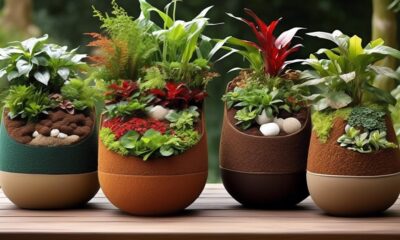
 Vetted5 days ago
Vetted5 days ago15 Best Wicking Materials for Self-Watering Planters, Tried and Tested
-
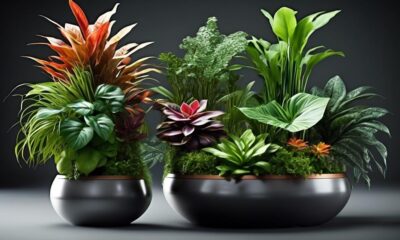
 Vetted3 weeks ago
Vetted3 weeks ago15 Best Self-Watering Pots to Keep Your Plants Thriving
-

 Vetted3 weeks ago
Vetted3 weeks ago15 Best Terrace Planters to Elevate Your Outdoor Space
-
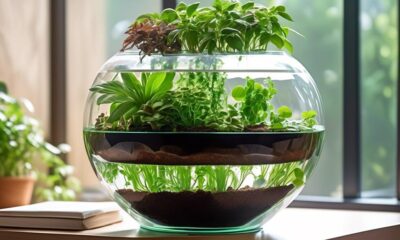
 Self Watering Plant Pots3 weeks ago
Self Watering Plant Pots3 weeks agoHow Do Self Watering Planter Pots Work
-
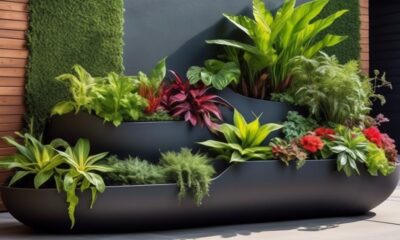
 Vetted3 weeks ago
Vetted3 weeks ago15 Best Wicking Planters to Keep Your Plants Thriving and Healthy
-
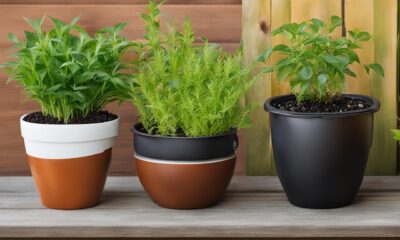
 Self Watering Plant Pots1 week ago
Self Watering Plant Pots1 week agoSelf Watering Outdoor Pots: Do They Work?
-

 Vetted3 weeks ago
Vetted3 weeks ago15 Best Waterwick Pots to Keep Your Plants Thriving and Healthy
-
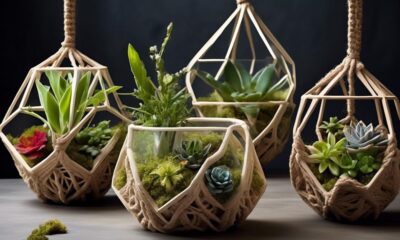
 Vetted3 weeks ago
Vetted3 weeks ago15 Unique and Wicked Planters to Elevate Your Indoor Garden















